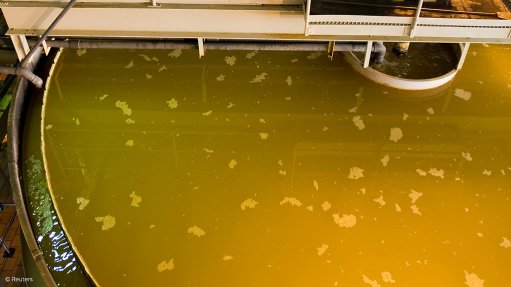
Photo by: Reuters
TORONTO (miningweekly.com) – Canadian uranium producer Cameco has posted lower-than-expected headline earnings for the three months ended March 31, despite reporting higher earnings from its fuel services and Germany-based NUKEM segments on higher sales volumes, which were partially offset by lower earnings in the uranium segment.
Excluding special items, the Saskatoon, Saskatchewan-headquartered miner reported earnings of C$69-million, or C$0.18 a diluted share, compared with C$36-million, or C$0.09 a share, in the year-earlier period.
Nine Bay Street analysts had on average expected Cameco to earn C$0.25 a share on revenue of C$562.52-million.
The company, which was responsible for about 16% of the world’s uranium output, recorded consolidated revenue of C$566-million, up 35% over the same period of 2014.
This was driven by uranium revenues, which accounted for 65% of consolidated revenues in the first quarter, being up 6% owing to a 1% increase in sales volumes and a 4% increase in the Canadian dollar average realised price, as well as a 65% jump in fuel services income and trebled NUKEM takings.
Cameco reported a net loss attributed to equity holders in the first quarter of C$9-million, or C$0.02 a share, compared with net earnings of C$131-million, or C$0.33 a share, in the same quarter a year earlier. The net loss was mainly owing to higher mark-to-market losses on foreign exchange derivatives.
Cameco's uranium sales rose 1% to seven-million pounds, while its average realised uranium price fell 7% to C$43.42/lb.
At 5.1-million pounds, uranium output in the first quarter was 11% lower year-on-year, mainly owing to lower production from the company’s key Athabasca basin operations at McArthur River/Key Lake and its in situ recovery operations in the US and Kazakhstan, partially offset by higher output at Rabbit Lake and production from Cigar Lake.
Cameco raised its budget for the year by 9.5% to C$405-million, mainly owing to an increase in the cost to modify Areva's McClean Lake mill to allow it to operate at 18-million pounds a year, as well as the timing of expenditures on projects at McArthur River and Key Lake.
Cameco expected to lift revenue for all of its segments by between 5% and 10% this year, driven mainly by a further weakening Canadian dollar.
Uranium output would this year be between 25.3-million pounds and 26.3-million pounds and sales were expected to range between 31-million pounds and 33-million pounds.
Cameco characterised the market in the first quarter as having changed little from the last quarter of 2014. The modest level of contracting activity was comparable to the previous quarter, with no significant strength or weakness emerging.
On the positive side, China started approving new reactor projects after a hiatus following the 2011 events in Japan and four reactors under construction in China joined the grid. As a result, China now had 26 reactors operating and 23 under construction. On the supply side, production issues at several large uranium mines threatened to tighten supply in the coming year, despite the market impact having not yet been significant.
Japan continued to experience difficulties with reactor restarts this year, with the country reporting a mix of both negative and positive developments.
At McArthur River, the world’s largest uranium mine, the Canadian Nuclear Safety Commission had approved an application to lift the licenced production limit to 25-million pounds a year on a 100% basis, which matched the yearly output licence limit at the Key Lake mill. The final step in the approval process remained the provincial nod.
Cameco had also recently struck a supply agreement with the Department of Atomic Energy of India to provide 7.1-million pounds of uranium concentrate under a long-term contract through to 2020.